Leading 36 railway engineers for eight days, with 24 technical visits and presentations, seven hotels, 20 train journeys, five coach transfers and one flight is no easy task. Yet, members of the Railway Division of the IMechE have organised such annual railway technical tours for decades, with Felix Schmid having led the committee for the past six tours.
In May 2023, the tour visited Finland, Sweden, and Norway. As always, it was a great opportunity to study railway engineering elsewhere and learn from each other. The opportunity for informal chats with senior engineers was particularly useful for the younger engineers.
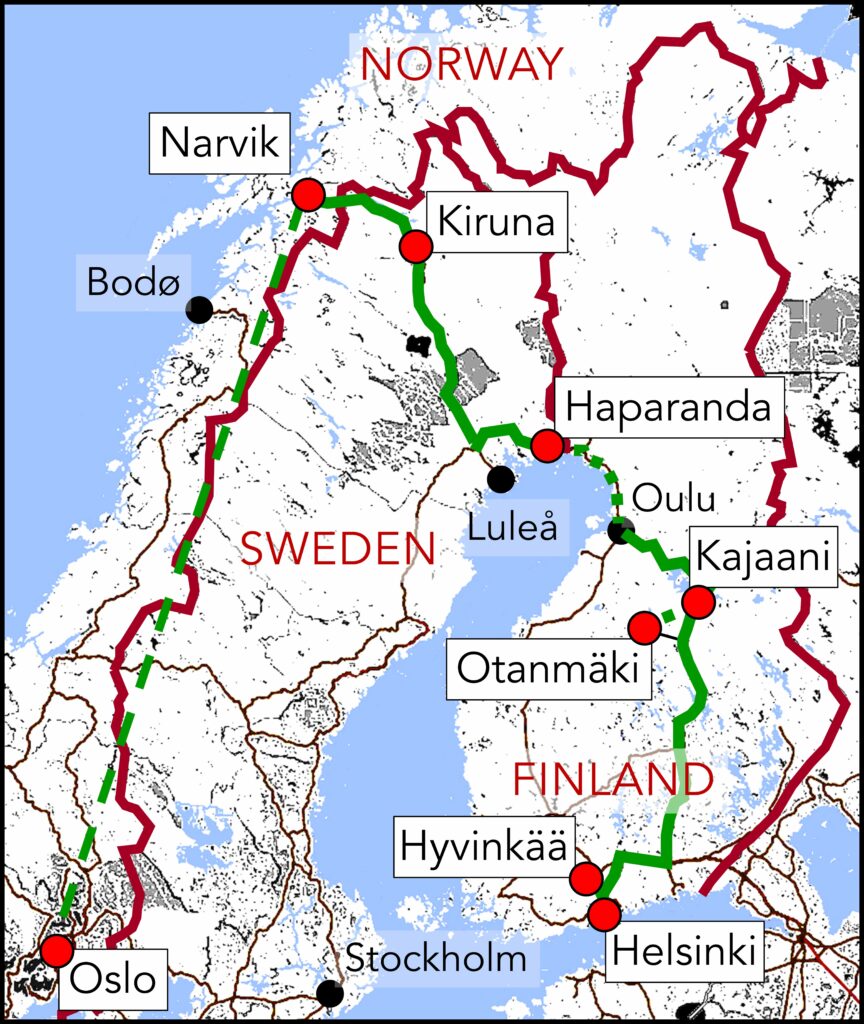
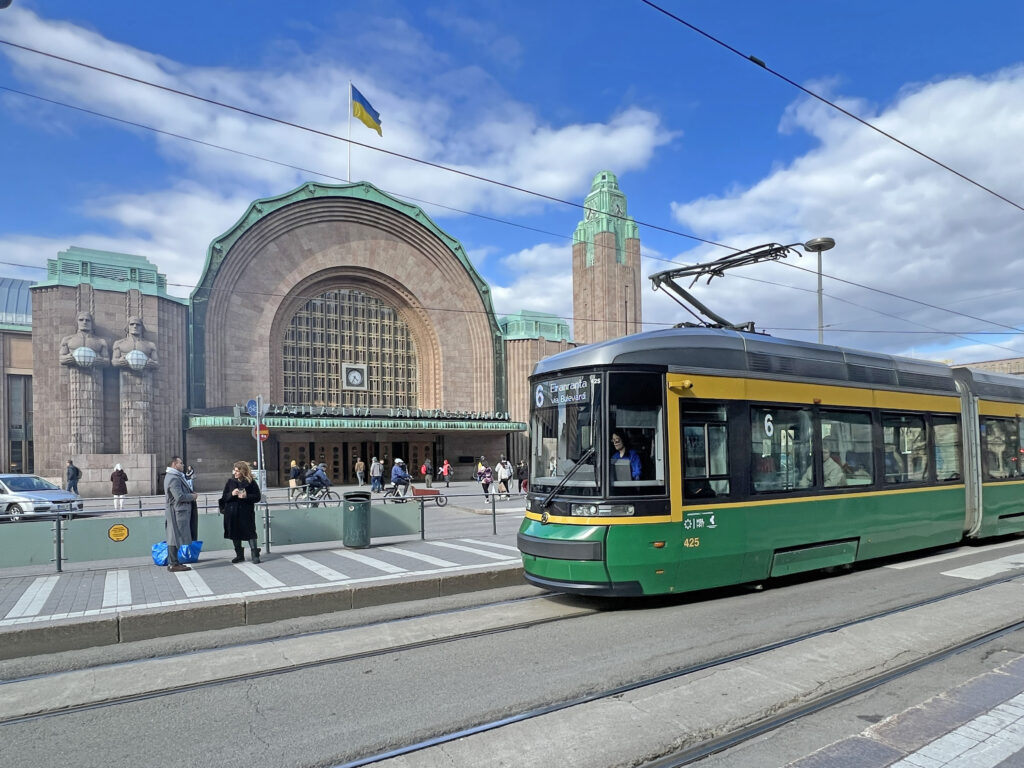
We started in Helsinki, where Mobility as a Service (MaaS) was launched in 2016. MaaS is the Netflix of transportation. For a monthly fee, it provides unlimited public transport use through an app which is a combined ticket and journey planner. Its introduction saw a significant increase in use of the city’s public transport.
HSL
Helsinki Region Transport (HSL) organises public transport in Greater Helsinki which has a population of 1.4 million. HSL’s €17 two-day public transport ticket enabled participants to sample its metro, buses, ferries, suburban rail network and trams. The 124 low-floor trams operate on a 62km tram network with 310 stops, producing 42 million trips a year.
The 43km Metro network opened in 1982 and has been extended progressively. The last section, in 2022, was a 7km tunnelled westerly extension with five new stations, bringing the total to 30. The metro carries 70 million trips per year, with a 150 second peak headway. In winter it operates in temperatures of minus 20°C.
Its 50 trains comprise three classes: M100 manufactured by the Finnish Stromberg company in the 1970s; M200 produced by Bombardier in the 2000s; and the M300 manufactured by CAF in 2016.
At the Metro’s maintenance depot and control room we learnt of plans to increase capacity by 25% by 2030. This requires additional trains and the implementation of Communication Based Train Control (CBTC) to provide automatic train control and shorter headways. HSL are also planning five new light rail / tram projects.
Finland’s railways
The 5,926km Finnish railway network is 88% single track and 56% electrified at 25 kV 50 Hz. It is built to the Russian loading gauge which is 5.3-metres high.
At the Finnish Railway Museum in Hyvinkää we learnt that railways came comparatively late to Finland as it was doubted that they could operate in extreme cold. The first 96km line opened between Helsinki and Hämeenlinna in 1862. As Finland was part of Russia at that time the track was the then Russian gauge of five feet (1524mm). Russia now uses a 1520mm gauge. The first locomotives were imported from Britain such as the museum’s 1869 Glasgow-built Class C1 0-6-0 goods locomotive. Once Finland became independent from Russia in 1917, railways had reached all major cities, ports, and the Swedish border.
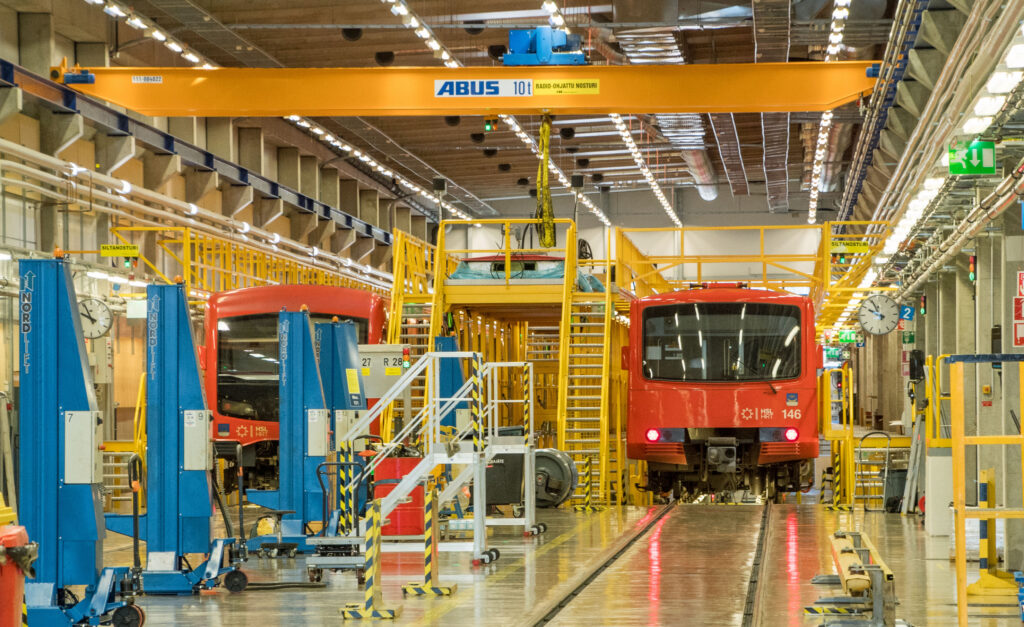


We benefited from the Russian loading gauge when leaving Helsinki on a 600km train journey to Kajaani on a Finnish double deck train whose coaches are 26.4 metres long, 3.2 metres wide, and 5.2 metres high, each typically with 113 seats. Various novel features included a children’s play area and small private compartments.
Figure 5 – Finnish double decker train.
The Skoda plant, where these coaches were built, was our next visit. This factory had also assembled the Bombardier-built 6 MW Sr2 electric locomotive which hauled the train to Kajaani, a 40km coach journey to the factory.
Skoda’s works
The remote village of Otanmäki is an unlikely location for the world’s most northerly rolling stock factory. Here, Škoda Transtech Oy, had produced 270 double decker cars, designed to operate down to minus 40°C, the first of which was delivered in 1998. The plant has 600 employees and occupies 57,000 square metres. When is it minus 35°C outside, the temperature inside is maintained at 18°C since welding is not possible in cold conditions.
We saw Skoda’s Arctic trams being produced for Helsinki and Mannheim, as well as products such as heavy mining machinery. Though the plant can produce complete vehicles from bare metal, some are sent to Skoda’s Czech Republic plant for final assembly. The plant’s production capability is one tram every two or three weeks.
We saw the plant’s fabricating, welding, machining, surface treatment, and assembly lines. Where possible, processes are automated, notably machine cutting and robotic welding. It was stressed that the trams are designed for ease of maintenance. Hence there were very few glued components.



To Sweden
From Kajaani, it was a two-hour train journey to Oulu, followed by a 140km coach trip to Haparanda in Sweden, on the Finnish border. Although passenger trains between Finland and Sweden ceased in the 1990s, there are now plans to re-introduce them and electrify the connecting lines. A complication is the gauge change. 1524mm tracks extend to Haparanda and standard gauge tracks extend to Tornio in Finland. Hence there are interlaced 1435 mm and 1524 mm tracks on bridge over the river that forms the border.
Haparanda is at the end of a branch line with an infrequent service, yet it has one of Sweden’s largest station buildings. When completed in 1918, it had many passenger trains as, during WW1, sea ferries between Finland and Sweden were not safe. As was evident from the Balises and marker boards, this 156km branch line has ETCS Level 2 signalling.
From Haparanda, it was a 1.5 hour train journey to Boden and then a four-hour northbound journey across the Arctic Circle to the iron ore city of Kiruna. The train arrived from the north as the line from the south has been diverted and the original station has been demolished. This is because the city is being undermined by subsidence from the iron ore mine to which it owes its existence.
Kiruna’s mine
With an iron ore body 4km long, 80 metres thick, and reaching a depth of 2km, Kiruna has the world’s largest ore mine. Mining started there in 1898. Since then, seven mining levels have been constructed. The latest, 1.2km below the surface, started mining in 2013. As the ore body is sloped, subsidence from removed ore advances further beyond the mine as the mining gets deeper. As a result, the city must be partly demolished, and its centre moved 3km east.


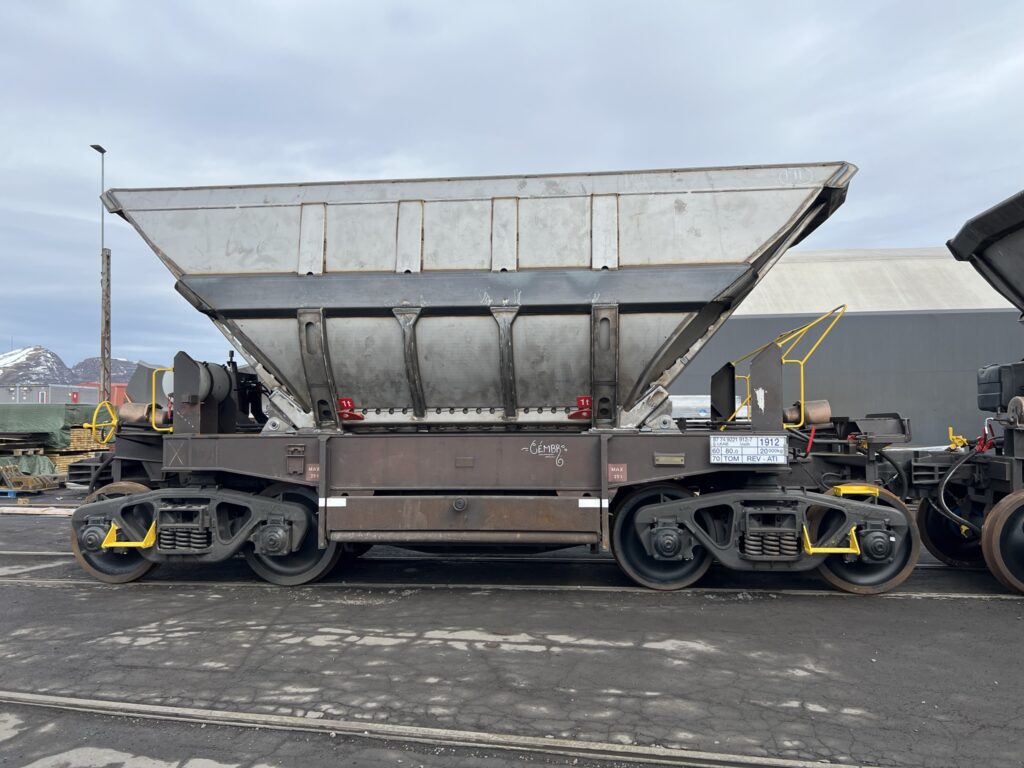
The mine is operated by the Swedish company LKAB which invested £1.2 billion in the latest level which required the removal of 4.3 million cubic metres of rock and 87km of new tunnels. Rail Engineer went down the mine in 2013 to report on the new level’s standard gauge railway (Issue 107). This is a 15km network on which the mine’s seven trains carry around 100,000 tonnes of ore per day, in 125 train movements between 10 ore extraction chutes and four crushing plants.
Each train consists of 21 unbraked wagons carrying 700 tonnes of ore. The 108 tonne Bo-Bo locomotives have four 225kW AC traction motors powered from an overhead 750V DC supply. Train movements are controlled by Bombardier’s INTERFLO 150 CBTC moving block system which offers variable moving blocks.
Using a railway, results in automation, allows high capacity and, unlike conveyors, can handle unevenly graded extracted ore.
From the underground crushing plant ore is lifted to the surface and processed into approximately 3,000 tonnes per hour of pellets and fines. Transporting ore at this rate to ships is a job for surface railways.
Iron Ore trains
From Kiruna there are typically ten trains per day to Narvik in Norway and four to Luleå in Sweden. The trains are 750 metres long with 68 ore wagons, each with a tare weight of 23 tonnes. The maximum 31 tonnes axle load allows each wagon to carry 101 tonnes of ore. Hence each train can carry 6,900 tonnes of ore. There are plans to increase this by raising the axle load to 32 tonnes.
The wagons operate in pairs with brake control equipment on one wagon to reduce air consumption. Owing to the harsh winter conditions it is important that compressed air in the braking system is kept dry for which the locomotives have effective air driers. Brake pipes also have special rubber seals. Wagons often need to be de-iced prior to unloading.
Wagons have Radio Frequency Identification (RFID) tags to calculate mileage and identify faults from wayside heat and acoustic vibration detectors that assess axle bearing and wheel condition. Wagon wheel life is six to nine years.
We also saw these wagons under construction at the plant of the Kiruna Wagon company which employs 30 and was founded in 2004. Since then, it has produced 1,600 wagons, mainly for LKAB. The company specialises in the manufacture and refurbishment of various types of dumper wagons i.e., bottom, rock, helix and turn dumpers. Its production capacity is seven wagons a week.
LKAB has 17 pairs of IORE electric locomotives, which have a top speed of 80km/h when unloaded and 60km/h when loaded. At 10,800kW (14,500 hp) and 2 x 180 tonnes, these are amongst the world’s most powerful and heaviest locomotives, with steel body panels 4cm thick. During the descent to Narvik, their regenerative brakes recover around 25% of the energy consumed which is sufficient power to haul empty trains back to Sweden.
LKAB has a programme to extend locomotive life by 20 years, which takes 15 weeks for each locomotive.
The Kiruna to Narvik line has 60kg/m rail to carry its 33 million gross tonnes per annum. Half the line has curves of less than 500 metre radius requiring 7km of rail to be renewed each year. Rail grinding is done every 20 million gross tonnes. With 19 avalanches last year, the line is difficult to operate in winter.

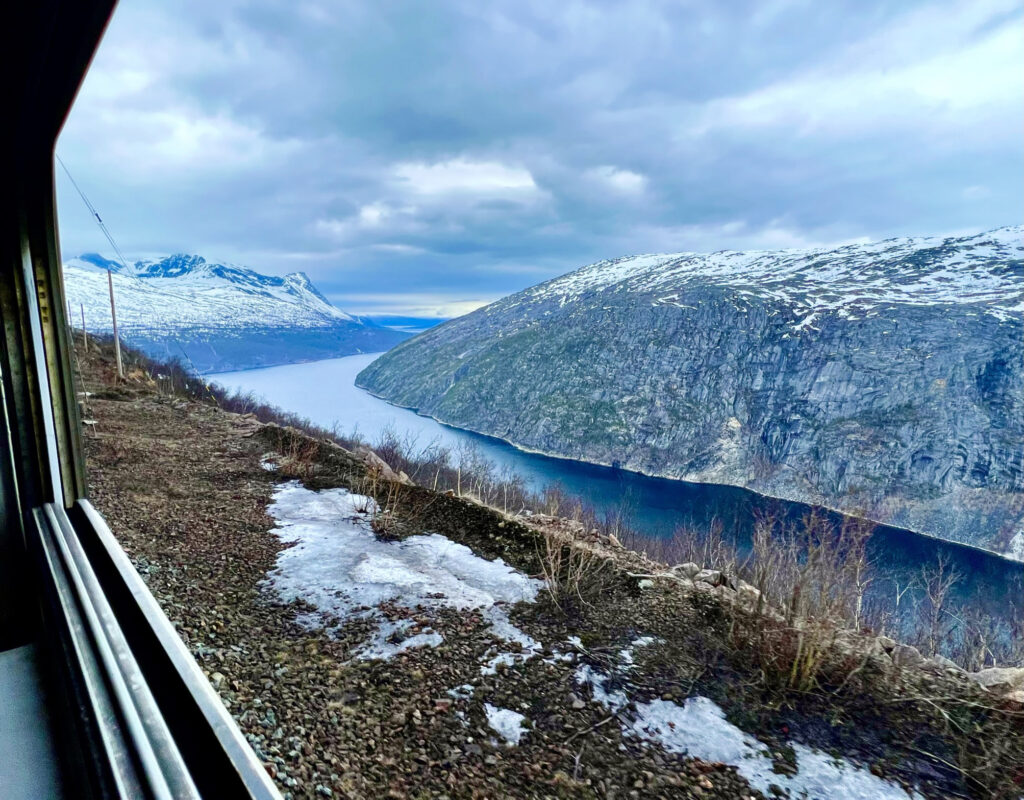

Narvik
The 170km line from Kiruna to the ice-free port of Narvik was completed in 1902 and electrified in 1923. Leaving Kiruna, the line climbs at up to 1 in 91 to its 523-metre summit on the Swedish / Norwegian border after which it clings to the side of a fjord as it descends to Narvik, 42km away, with a maximum gradient of 1 in 60, a stunningly beautiful journey.
At Narvik, we saw LKAB’s port facility which handles 70,000 tonnes of ore daily and loads up to 30 million tonnes per year into ships. Trains arriving from Kiruna run at a continuous slow speed into a shed to deposit ore into one of the 12 underground silos which are each 60 metres deep and 38 metres in diameter.
Conveyors underneath these silos direct the ore to one of two loaders which load 9,000 tonnes of iron ore per hour into the ships. The port has a 27-metre draft to handle ships of up to 350,000 tonnes. Typically, ships are loaded with 30 train loads of iron ore.

Norwegian railway developments
The 4,087km Norwegian railway network is 94% single track and 64% is electrified, like Sweden, at 15 kV 16 2/3 Hz. Narvik receives about two freight trains a day from Oslo which involves a 1,900km, 27-hour journey almost all through Sweden. With increasing traffic there are plans to increase the line’s capacity with two additional passing loops and track remodelling at Narvik station.
The unelectrified 729km Nordland line, from Trondheim to Bodø, also requires more passing loops for additional traffic and will be one of Norway’s first ETCS equipped lines.
The Norwegian passenger fleet comprises 18 train classes with 278 trainsets and 135 coaches. The train procurement strategy will see these 18 classes reduced to five. Trains already ordered include 30 Alstom Coradia Nordic trains for local services and 17 x 8-coach Stadler long-distance trains.
Follobanen
From Narvik, we had a 1,000km flight to Oslo to learn of suburban rail and metro developments. On arrival, we learnt about the Follobanen project. This is a new 22km double track railway between Oslo Central Station and Ski, south of Oslo. Construction commenced in 2013 and was completed in 2022, costing £2.7 billion.
The new route is mostly in a 19km twin-bore tunnel whose construction utilised four Tunnel Boring Machines, from 2016 to 2019, as well as the ‘drill & split’ method in complex areas. Whilst slower and more expensive, this method reduced vibrations in central Oslo. It involves inserting hydraulic pins into drilled holes which then ‘split’ the rock.
The project’s track design principles were ‘lines that separate, shall not meet again’ and ‘no tracks shall cross at grade’. This has generally been achieved, with one unavoidable exception outside Oslo Central Station. Between Oslo and the newly expanded Ski station, the new line now offers non-stop 200km/h trains, whilst the existing line has 80km/h stopping commuter services. Hence, overall capacity has been increased from 12 trains per hour (tph) to 40 tph and journey times cut from 22 to 11 minutes on fast services.
Oslo’s Metro
Oslo’s Metro system has 101 stations, the highest being 469 metres above sea level on a line with a 1 in 17 gradient. It comprises 5 lines which all converge through the underground core section that has a capacity of 28 tph and has 115 x 3-car Class MX3000 trains. Unusually, the 88km network has 12 level crossings.
The system is currently being resignalled with a £230 million CBTC system, awarded to Siemens in 2021. This should be commissioned on an outer part of the system by December 2024, after which it will be progressively rolled out over the full network to increase capacity through the core section to 40 tph. The project includes fitting the CBTC system to the trains and installing a new traffic management system.
A world first for this CBTC system will be its use of public mobile networks for track-to-train communication to provide a higher quality datalink at a reduced cost. For redundancy, each train will be connected to two network operators who will give it priority. However, this approach presents cyber security challenges.
Another major Oslo Metro project which started in 2020 is a £2 billion, 7.7km tunnelled extension to Fornebu with six new stations and an underground depot stabling 28 trainsets with three workshop tracks and a turnaround loop. Services on this extension should commence in 2029.
Tunnelling is by drill and blast rather than a boring machine due to the number of stations in this relatively short tunnel. Tunnelling started in 2020 and after 18 months is 40 % complete.
Scandinavian ETCS
During the tour we learnt about the Swedish and Norwegian ETCS programmes.
Sweden’s 10,912km rail network has four connections with Norway and one with Denmark, highlighting the importance of achieving ETCS’s interoperability. It has 750 interlockings which will soon be life expired. ETCS will reduce the number of interlockings to 150. Initially, ETCS will be implemented on low trafficked regional lines, like the Haparanda branch. By 2027, ETCS will have been installed on 450km of four such regional lines.
The line from Boden to the Norwegian border via Kiruna was planned to have ETCS this year but this has now been postponed to 2024 due to delays supplying train borne equipment. ETCS contracts have been let to Alstom, Siemens, and Hitachi for onboard equipment and to Alstom and Hitachi for trackside equipment.



The Swedish ETCS programme should be completed by 2040 with the lines around Stockholm being at the end of the programme. Swedish railways have around 100 different types of trains totalling 1783 vehicles requiring ETCS fitment at an estimated cost of £1 billion.
Whilst in Oslo, we visited Campus Nyland, Norway’s ETCS test, training and simulation centre which opened in 2019. Here we tried out ETCS driving simulators, saw the ETCS infrastructure laboratory, and visited an adjacent depot to see trains being fitted with ETCS. Alstom have the contract to equip 467 trains of 55 different types. This is being done on two roads in the depot with each unit being out of service for two to three weeks.
Norway opened its pilot ETCS line in 2013 and had planned to open its next line this year but this has now been postponed to early 2024. Norway plans to implement ETCS on low trafficked lines first to help manage rolling stock fitment. Hence, lines to Oslo will be ETCS fitted at the end of the £2.6 billion programme which is expected to be completed by 2034. ETCS contracts have been awarded to Thales for the traffic management system, Alstom for train equipment and Siemens for infrastructure equipment. Siemens is responsible for system integration and managing design records.
Though ETCS offers many benefits, the group also heard about significant issues which add cost, delay, and operational constraints. These included:
The need to freeze rail infrastructure for several years for ETCS implementation is a significant operational constraint, requiring detailed long-term planning,
Complex approval process, largely due to a very large number of combinations of different trackside kit and on-train equipment;
Developing and approving first of class train installations is a long and expensive process;
For retrospective fitment, the size of on-train equipment is problematic. Tour participants noted that smart phones offer greater functionality in a much smaller space;
Manufacturers unable to meet demand for high volume of ETCS kit;
Potentially high cost as suppliers have a monopoly for the kit they supply.
To address this last issue, the EULYNX initiative has been developed to standardise the interface between signalling system elements. On our first day, the Finnish company, Relesoft, presented its EULYNX compliant interface, which was used in Finland to upgrade a traffic management system without renewing the interlocking. Relesoft describes itself as the “SpaceX of signalling” as it is quite a small company with the potential to disrupt the commercial model of mainstream suppliers.
Shared learning
After eight intense days, everyone had learned much from the visits and from each other on a trip that offered a unique insight into Scandinavian railways. Key aspects included integrated public transport and impressive capacity-improvement projects, designing railways for extreme cold weather and manufacturing trains from bare metal.
The scale of Kiruna’s iron ore operation and the way that railways, above and below ground, have been designed to transport thousands of tonnes per day was particularly impressive. It was also instructive to learn how Sweden and Norway are implementing their ETCS programmes which, unlike the UK, start with little-trafficked lines. The very real problems of ETCS implementation were also highlighted.
As one younger member of the tour put it: “we can learn so much from how things are done in different countries”. Providing such an opportunity was just one reason why the Railway Division’s Technical Tour is such a worthwhile event.
Tour participants would like to thank those who organised the tour, all the group’s hosts in Finland, Sweden and Norway, and the event’s sponsors: Angel Trains and Eversholt Rail. My thanks also to the young engineers for their contributions to this feature. They are: Anish Bhunjun – Helsinki Transport; Jack Neil – Oslo transportation projects: Joe Brown – Finland’s railways; Logan Smith – ETCS; Zieger Xiao – Skoda & Kiruna Wagon works; John Thomas Puthusseril – iron ore transportation.

